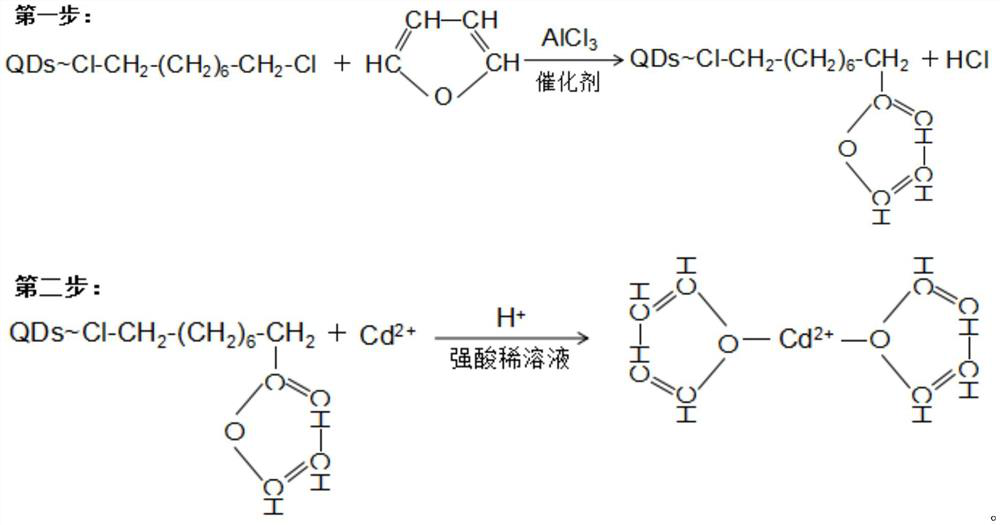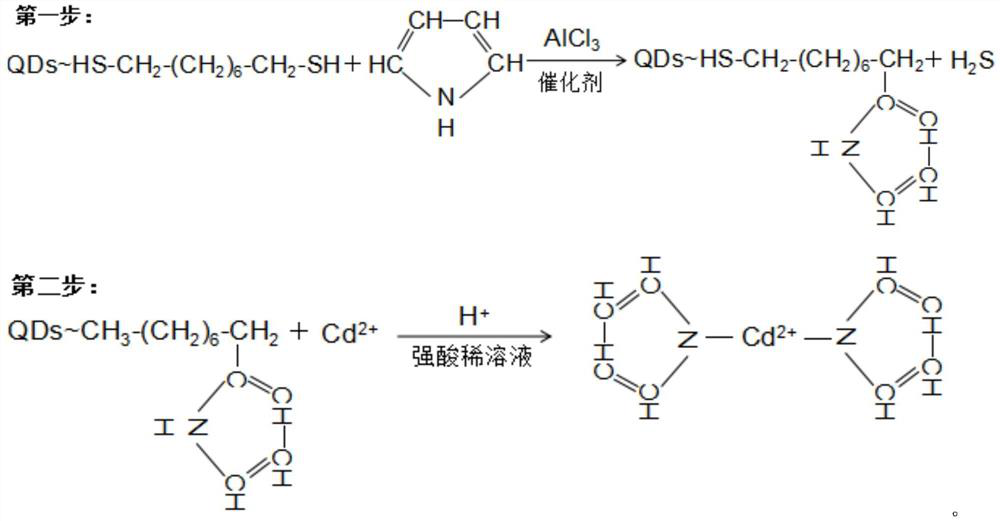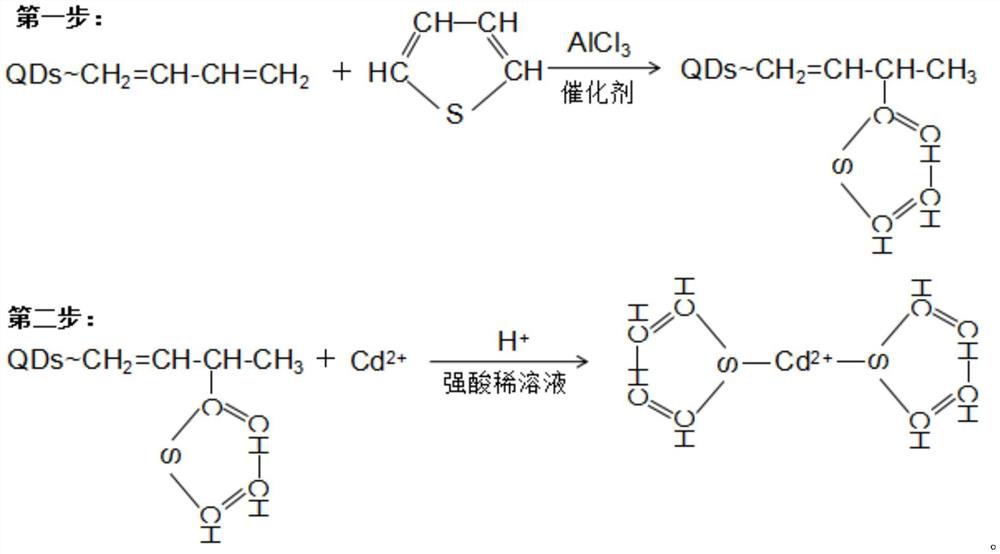Detection method of free cadmium ion
A detection method and technology for cadmium ions, applied in the field of quantum dots, can solve the problems of poor sensitivity and complicated operation.
- Summary
- Abstract
- Description
- Claims
- Application Information
AI Technical Summary
Problems solved by technology
Method used
Image
Examples
Embodiment 1
[0039] Taking CdS quantum dots as an example, the method for qualitatively detecting free cadmium ions is introduced in detail below; the detection method includes the following steps:
[0040] (1) Provide 1.5 g of CdS quantum dots modified with 1,8-dichlorooctane.
[0041] (2) Using nitrobenzene as a solvent, mix 1.5g of furan with 0.5g of anhydrous AlCl at 50 degrees Celsius 3 Under the combined action of the catalyst, a substitution reaction occurred with the CdS quantum dots modified by 1,8-dichlorooctane to form a surface coating layer, and it was confirmed that the autofluorescence of the quantum dots was quenched by ultraviolet light irradiation.
[0042] (3) Place the coated CdS quantum dots in a 3mol / L hydrochloric acid environment. If there are free cadmium ions in the quantum dot solution, the free cadmium ions will compete with the furan coated on the surface of the quantum dots. A coordination compound is formed to restore the self-fluorescence of the quantum dot...
Embodiment 2
[0047] Taking CdSe@ZnS quantum dots as an example, the method for qualitative detection of free cadmium ions is described in detail below; the detection method includes the following steps:
[0048] (1) Provide 8.5g of CdSe@ZnS quantum dots modified with 1,8-octanedithiol.
[0049] (2) Using nitrobenzene as a solvent, mix 8.5g pyrrole and 0.8g anhydrous FeCl at 70 degrees Celsius 3 Under the combined action of other catalysts, they reacted with 1,8-octanedithiol-modified CdSe@ZnS quantum dots to form a surface coating layer, and irradiated with ultraviolet light to confirm that the autofluorescence of the quantum dots was quenched.
[0050] (3) Place the coated CdSe@ZnS quantum dots in a 0.5mol / L sulfuric acid environment. If there are free cadmium ions in the quantum dot solution, the free cadmium ions will compete with the coating on the surface of the quantum dots. The pyrrole on the surface forms a coordination compound, which restores the self-fluorescence of the quantum...
Embodiment 3
[0055] Taking CdZnSeTe alloy quantum dots as an example, the method for qualitatively detecting free cadmium ions is described in detail below; the detection method includes the following steps:
[0056] (1) Provide 18.5g of CdZnSeTe alloy quantum dots modified with 1,4-butadiene.
[0057] (2) Using nitrobenzene as a solvent, mix 18.5g thiophene with 1.2g anhydrous FeCl at 60 degrees Celsius 3 Under the combined action of other catalysts, they reacted with 1,4-butadiene-modified CdZnSeTe alloy quantum dots to form a surface coating layer, and irradiated with ultraviolet light to confirm that the quantum dots' autofluorescence was quenched.
[0058] (3) Place the coated CdZnSeTe alloy quantum dots in a 1.0mol / L nitric acid environment. If there are free cadmium ions in the quantum dot solution, the free cadmium ions will compete with the quantum dots coated on the surface of the quantum dots. The thiophene forms a coordination compound, which gradually restores the self-fluore...
PUM
 Login to View More
Login to View More Abstract
Description
Claims
Application Information
 Login to View More
Login to View More - R&D
- Intellectual Property
- Life Sciences
- Materials
- Tech Scout
- Unparalleled Data Quality
- Higher Quality Content
- 60% Fewer Hallucinations
Browse by: Latest US Patents, China's latest patents, Technical Efficacy Thesaurus, Application Domain, Technology Topic, Popular Technical Reports.
© 2025 PatSnap. All rights reserved.Legal|Privacy policy|Modern Slavery Act Transparency Statement|Sitemap|About US| Contact US: help@patsnap.com



